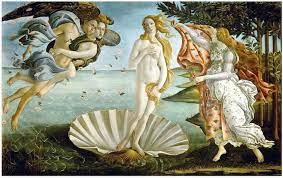Renaissance Blog - The Birth of Venus
Many works from the Italian
Renaissance still awe and move spectators today. This was a time of great
artistic and architectural achievement. Sandro Botticelli's painting "The
Birth of Venus" is one example. Many have recognized this artwork, which
was finished in 1486, as a masterpiece of its day and a brilliant illustration
of the Italian Renaissance style. The goddess Venus, who has just been birthed
from the sea, is depicted at the middle of the picture. The goddesses Zephyr
and Chloris, who are directing the winds of change and love, respectively, are
among the other figures that surround her. From Venus' delicate face features
to the sea's swirling waves, the picture is rich in allusion and detail. These
components all work together to produce a striking visual that will definitely
stir up strong feelings in the observer. A remarkable feature of "The
Birth of Venus" is its history. The Medici family is thought to have
commissioned the picture, which was probably intended to symbolize the family's
strength and power. This gives the artwork a further level of meaning by
serving to remind viewers that the Medici family was a major player in the
Italian Renaissance.
This painting's composition is also
excellent. The composition's different components have been balanced by
Botticelli in such a way that the eye is naturally led to Venus, who is
presented in the painting's center. The viewer can concentrate on the primary
characters and the story they are delivering since the background is painted in
a light and airy manner. Furthermore, the use of bright hues and light-dark
contrasts improves the painting's energy and creates awe in the observer. It's
also extremely impressive how "The Birth of Venus" is presented. To
give the picture a realistic feel, Botticelli applied a number of different
techniques. The artwork feels alive and lively, from the fine brushstrokes to
the fine details of the figures. The addition of gold leaf, which gives the
painting an additional air of grandeur and contributes to the feeling of awe,
enhances this further.
I would be pleased to show off a
copy of "The Birth of Venus" if I were to own one. It is not only a
lovely painting, but it also serves as a reminder of the successes of the
Italian Renaissance. The artwork is proof of the emotional power of art and its
capacity to stir up emotions. It also serves as a reminder of how crucial it is
to value the beauty of the environment.
Humanism was the movement of The
Renaissance. It placed value on the dignity of the individual and the worth of
the human experience. This movement had a big impact on art because it gave
creators permission to draw inspiration from their own life experiences. A
prime example of this is Botticelli's The Birth of Venus, which combines beauty
and complexity through the application of the artist's imagination and personal
experiences.
In summary, "The Birth of
Venus" is a magnificent illustration of Italian Renaissance artwork and
construction. The arrangement, colors, and use of light-dark contrasts in the
painting all work together to produce a potent image that is guaranteed to
evoke emotion and wonder in spectators. The background of the picture also
gives it a deeper meaning and serves to remind us of the accomplishments of the
Italian Renaissance.
Citation




I really enjoy looking at all the different components of The Birth of Venus created by Botticelli! There is an amazing use of depth, color, tone, and so much more. I would agree that the background definitely has a more light and airy feel to it. The colors seem to elicit feelings of calmness and peacefulness. I like that you touched on the fact that the more muted background colors help direct the viewer's attention to the figures in the painting. This seemed to be a very common technique in many works of art that were influenced by Humanism in the Italian Renaissance.
ReplyDeleteBecause Humanism was a philosophy that focused more on the individual, artists began to make the figures the focal point of their pieces. You touched on the realistic feel of the figures which was another goal that painters who adhered to the Humanist philosophy tried to achieve. Botticelli did a great job of incorporating small details to make his figures hyper-realistic. I found this article about Humanism in the Italian Renaissance Era very interesting and informative! Website: https://smarthistory.org/humanism-italian-renaissance-art/
Thank you for this great discussion and analysis!